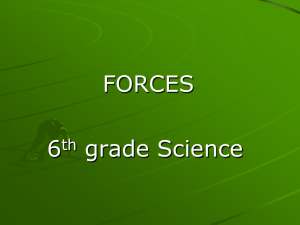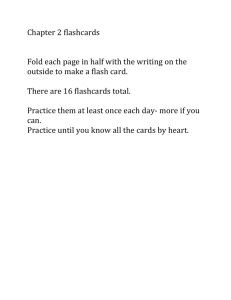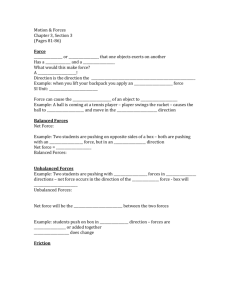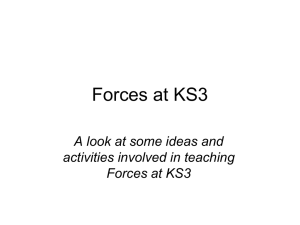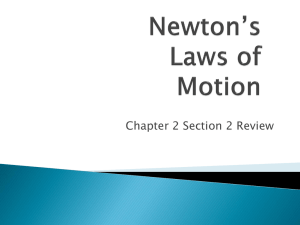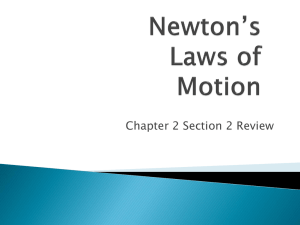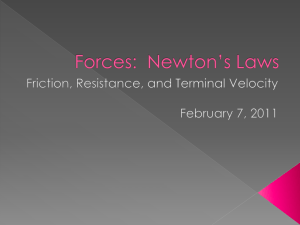Introduction to Forces Guided Discussion ppt
advertisement
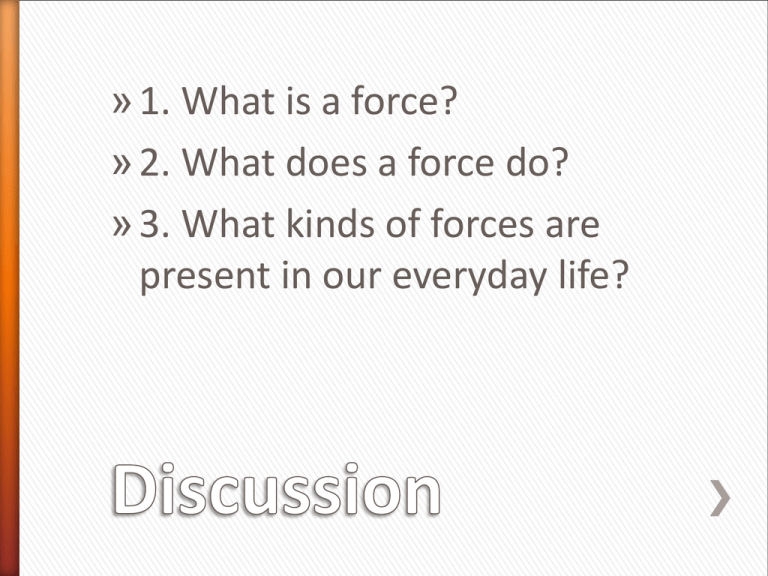
» 1. What is a force? » 2. What does a force do? » 3. What kinds of forces are present in our everyday life? Guided Discussion Student notes are shown in blue. » Any influence that can cause a change in an object’s motion. A bat strikes the ball with a force that causes the ball to stop and then move in the opposite direction. » A push or pull that one object exerts on another » Has a size and direction » Measured in newtons (N) You have to apply a force of about 3 N to lift a full can of soda. When two or more forces act on an object at the same time, the forces combine to form the net force. » The combination of all forces on an object Balanced forces: no acceleration In a tug of war, each side exerts a force on the ground. If the opposing forces on the ground are equal, they are balanced and the people do not move. Unbalanced forces: acceleration If one of the forces on the ground is greater than the other, the forces are unbalanced and the people move in the direction of the greater force. » Do not change motion » Cancel each other » Combine to produce a net force of zero » Do not have the same strength (size) » Cause acceleration » A force that opposes the sliding motion of two surfaces » Depends upon the materials the surfaces are made from and the roughness of the surfaces » Rule of Friction – Friction always acts in a direction to oppose motion. Examples: If you push a solid block along the floor to the right, the force of friction on the block will be to the left. A boat propelled to the east by its motor experiencing water friction to the west. When an object falls downward through the air, the force of friction (air drag or air resistance) acts upward. PUSH FRICTION AIR RESISTANCE WEIGHT Unbalanced forces: acceleration Balanced forces: constant speed Balanced forces: no motion A When a car is accelerating, the forces are unbalanced. The force moving the car forward is greater than the opposing force of motion. B When a car is cruising at constant speed, the forces moving the car forward is balanced by the force of friction. C This car does not roll because the force of friction between the brakes and the wheels balances the force of gravity. » Static Friction – The frictional force that prevents two surfaces in contact from sliding past each other. » Sliding Friction – The force that acts in the opposite direction to the motion of a surface sliding on another surface. » A type of frictional force that opposes the motion of objects that move through the air » Causes objects to fall with different accelerations and different speeds » Acts in the direction opposite to the velocity of an object moving in air » Size of the force depends on the size and shape of the object. The flying squirrel increases its area by spreading out. This increases air resistance and decreases the speed of its fall. Air resistance, not an object’s mass, is why feathers, leaves, and sheets of paper fall more slowly than pennies, acorns, and apples. As an object falls, the downward force of gravity causes the object to accelerate. As the speed of the object increases, the upward force of air resistance also increases. » When the upward air resistance force equals the downward force of gravity, terminal velocity is reached – the velocity becomes constant. » Depends on the size, shape, and mass of the object Terminal velocity is reached for the sky divers when air resistance balances the downward force of gravity.

